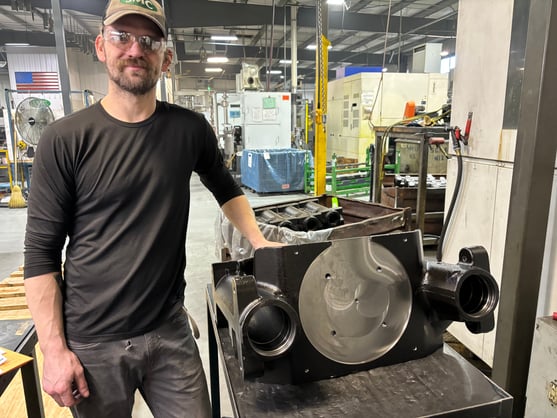CNC machining (computer numerical control machining), is precision machining that's fully automated, ensuring exceptional accuracy and remarkable precision. CNC machining achieves levels of complexity beyond conventional precision machining, plus it’s cost-efficient, particularly for complex components and parts.
Although CNC machines perform numerous tasks, milling is the most common and easy to understand. At its most basic, milling removes material from a stationary workpiece by bringing a rotating cutting tool into contact with it.
Manufacturing special features, however, like intricate profiles, presents challenges. This is where form milling shines. Ideal for forming irregular contours, form milling uses specially designed form milling cutters that match a particular shape exactly according to print specifications. For instance, the cutter's profile is concavely aligned to create a convex edge on a workpiece.
How Are Form Milling Cutting Tools Made?
Manufactured from materials such as tool steel, solid or brazed carbide, polycrystalline diamond (PCD) or high-speed steel (HSS), customized cutters require significant time and cost to craft (we’ll explore the types of form milling cutters later).

Lead times on specialized form tools vary. Most often, preforms are needed to start the process. A preform is made and then ground to an exact profile. In certain instances, carbide gets brazed into the cutter pockets to secure the carbide in the cutter. Then, once the tool is deemed worn, the cutter gets sent back to the manufacturer to remove the carbide. They inspect the pockets and, if they’re in spec, new carbide is inlaid and the geometry is finished with a final grind.
This same process is done for a PCD form tool. As for a solid carbide or HSS cutter, the cutter gets inspected. If it’s not too worn, it’s resharpened. Once done, all tools get re-inspected before sending back to the customer (the CNC machine shop).
What Materials Are Right for Form Milling?
An example of form milling’s versatility is its use on various materials such as plastics, composites, and metals like aluminum alloys and cast iron.
Form Milling vs. Other Milling Types
Form milling stands out for its ability to cut specific and unique features and can cut multiple shapes at one time with superior surface finishes.
Although the initial costs to form tools can be high, the savings in cycle times outweigh using multiple tools. Using form tools eliminates multiple tool changes by combining cutters for multiple features into one tool. Time is money, as they say!
Running parameters, which depend on the features and material, may need to be reduced but not always. If you cut a solid surface, you typically open the feature up with a core drill. Then, you go in with a semi-finisher tool that provides the initial feature shape.
Next, you use a finish tool like a step reamer. Step reamers finish the feature’s diameters and the final shape of the print feature. Form tools are not necessarily for high-volume jobs only. Sometimes, the difficulty of a feature dictates whether a form tool will be best.
Advantages of Form Milling
- Capable of cutting challenging contours
- Delivers precise and uniform results
- Enhances efficiency by reducing multiple milling operations
- Reduces total costs
Challenges of Form Milling
- Design and setup take time, increasing the cost of individual pieces for short runs (larger batch productions are more economical)
- Not cost-efficient when producing low-value, small-quantity components
- Programming in G-code and acquiring custom tools may cause delays
- Quality assurance of machined parts due to inconsistent cutting
How Does Form Milling Work?
Form milling involves a series of steps and shapes. Initially, the blueprint identifies the form or shape. Using a part 3D CAD model is also a big help. Once it’s designed, a 3D model of the tool is created and inserted into the part model. It’s reviewed to ensure that it’s an exact match to the model (checking the dimensions from the print).

In the CNC machine, the form milling cutter is set up, and the workpiece is firmly secured on the milling machine — in a vise, attached to the bed, or fixtured — to ensure stability during milling. Indicating the tool in the spindle is critical to the success of the cutter. Normal runout condition is 0.0002” or less. Each spindle is different, so it’s crucial to indicate any special form tool.
Before cutting, parameters must be established: spindle speed, depth of cut, cutting direction, and feed rate. Also, a dry run — running the tool in front or alongside the workpiece — keeps the tool off of the part while ensuring the part programming and running parameters are correct. Any mistakes can be solved after “cutting air,” and production can move to cutting actual material.
RELATED: 22 CNC Machining KPIs You Should Really Care About
Types of Form Milling Cutters
In general, there are three main types of form milling cutters:
Concave and Convex Cutters
- Concave cutters shape convex contours on workpieces, available in various curvature radii. Convex cutters, with half-round profiles, create concave features. Each is equipped with multiple flutes or insert teeth for material removal and varies in the number of flutes based on the complexity of the profile and the tool’s size. This design enables the efficient and accurate production of complex components.
Form Tools
- Solid form tools are ground to match a profile. Form tools are commonly used to cut features like hydraulic ports. Indexable form tools can be customized to cut multiple features at once, including multiple diameters and chamfers.
Corner Rounding Cutters
- Used for rounding corners on parts, these cutters have a concave quarter-circular profile. They efficiently create smooth radii on corners, reducing passes and eliminating steps typical with standard cutters.
Choosing the Right Form Milling Cutter
Selecting the right form milling cutter is crucial for achieving high precision. These specialized cutters offer enhanced control and accuracy, especially when a single custom cutter integrates multiple shape aspects. Ideal for intricate shapes such as hydraulic ports and spool bores, form milling cutters ensure precise contour replication and high-quality finishes.
Tailored to exact shapes and dimensions, form milling cutters provide consistent accuracy and repeatability with less effort and skill. Form milling cutters are efficient, maintain uniformity across fast production runs, and are ideal for machining many identical components.
Form milling is just one CNC machining technique. An experienced CNC machine shop can explain more about machining and help you determine which technique is appropriate for your application. Yet, how do you know when it’s time to work with a high-end CNC machine shop? Our guide has advice to share; click the link below to get your copy.







